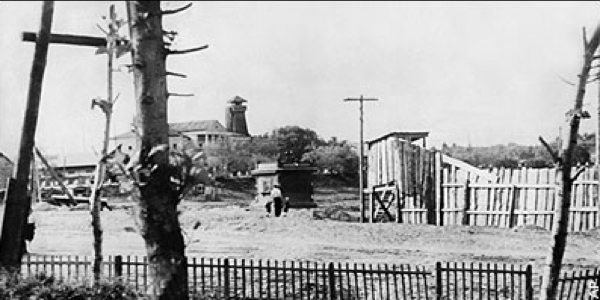On March 11, 1933, a plan for a very different kind of gulag was presented to Joseph Stalin. Devised by Genrikh Yagoda, Stalin’s head of the Secret Service and Matvei Berman, the head of the Soviet Gulag system, the scheme proposed that the government resettle 2,000,000 political undesirables in self-sufficient settlements in Siberia and Kazakhstan. The idea was that the “settlers” would work to bring a million hectares of untouched land into agricultural production, thus helping famine struck Russia– and sustaining themselves. So, in May 1933 the first assortment of 6,000 political dissidents and petty criminals were loaded up into trains. Their destination was the isolated Western Siberian Island of Nazino.
The Nazino colony was meant to achieve self-sufficiency in two years. However, thirteen weeks after its conception, the project had failed spectacularly. For the settlers were abandoned in a hostile Siberian wilderness, under-resourced and unprepared. All too soon, anarchy, violence, and disease became rife in the community. When the authorities finally intervened, after the rejection of the plan by Stalin, they discovered that 4,000 of the original deportees were either dead or missing. Most disturbingly of all, however, was the number of survivors who had turned to cannibalism. Until Glasnost, the Nazino Affair remained buried. Since then, historians have revealed what happened on that remote Siberian Island.

A Different Kind of Gulag
Gulags were an essential part of the penal system in the Soviet Union of Stalin. They were concentration camps specifically designed for severe criminals and political dissidents. However, many prisoners were innocent of any crime -except falling foul of the Soviet system. In the early 1930s, the numbers of potential gulag prisoners began to increase. Some were peasants who had rebelled against the collectivization of the land in the 1930s. Others were former Kulaks, wealthy peasant farmers who had been declared “enemies of the people” for owning their land and employing people. However, the Gulags also began to swell with those newly deemed urban “undesirables.”
On December 27, 1932, the Soviet government issued a new kind of ID document. These ‘internal passports’ were denied to “persons not engaged in industrial or other socially-useful work from towns.” Officials believed issuing these documents would, help cleanse “towns from hiding Kulaks, criminals and other antisocial elements.” With such a passport, a person was an acknowledged Soviet citizen and allowed to move from city to city. However, anyone who refused one was trapped and liable to be rounded up.
Peasants were denied internal passports to prevent them from escaping to the city from the collective farms. So those already hiding urban areas were immediately caught out by the new system. However, passports were also refused to “superfluous elements not connected with productive or administrative work.” These included many members of the former upper classes who had no place in the new Soviet state. Passes were also denied to “antisocial and socially dangerous elements’- in other words, criminals.

The question was, what to do with all these “antisocial elements”? The answer was a new kind of Gulag. Instead of camps, the government would set up new ‘labor villages” in the most inhospitable hinterlands of the Soviet Union. Although the settlements would be guarded so that none of their occupants escaped, they would be self-supporting communities- and passportless individuals would people them. The ‘aim of the game’ was to set up the new settlements “as cheap as possible.” As a result, the original target of 2,000,000 deportees over ten years was halved. However, worries about costs did not stop the deportations beginning immediately- even before Stalin had given his official approval.
In May 1933, 85,937 deportees from Moscow and 4776 from Leningrad were placed in a transit camp at Tomsk, waiting to be shipped out to their new homes. Many were peasant farmers, who would at least have had some inkling of how to eke out a living in an inhospitable rural environment. However, the rest were former merchants, traders and hapless urban citizens picked up without papers. In amongst them were also some of the overflows from Moscow and Leningrad’s overcrowded prisons. The Transit camp officials decided these urban deportees should be the first to go.

